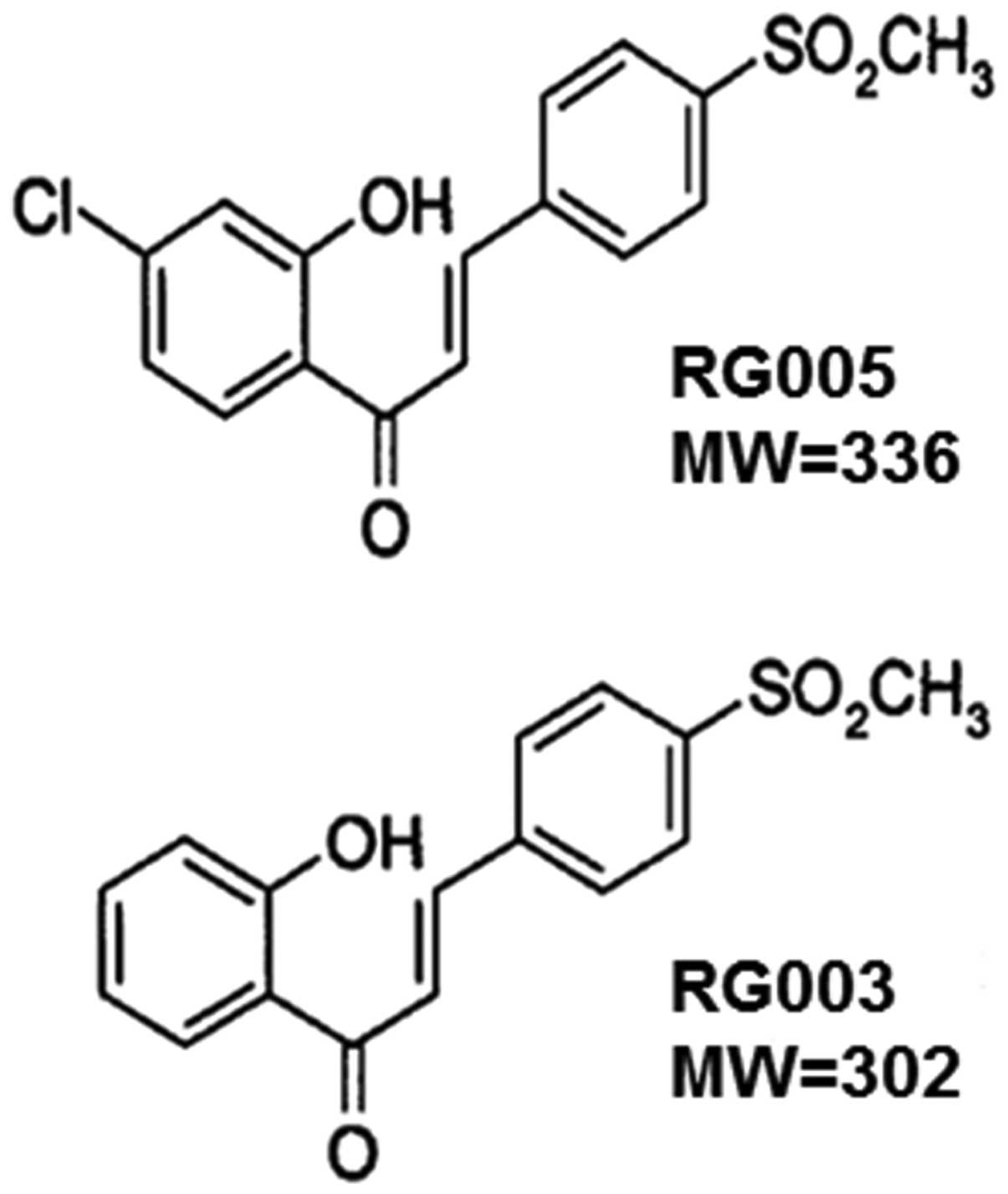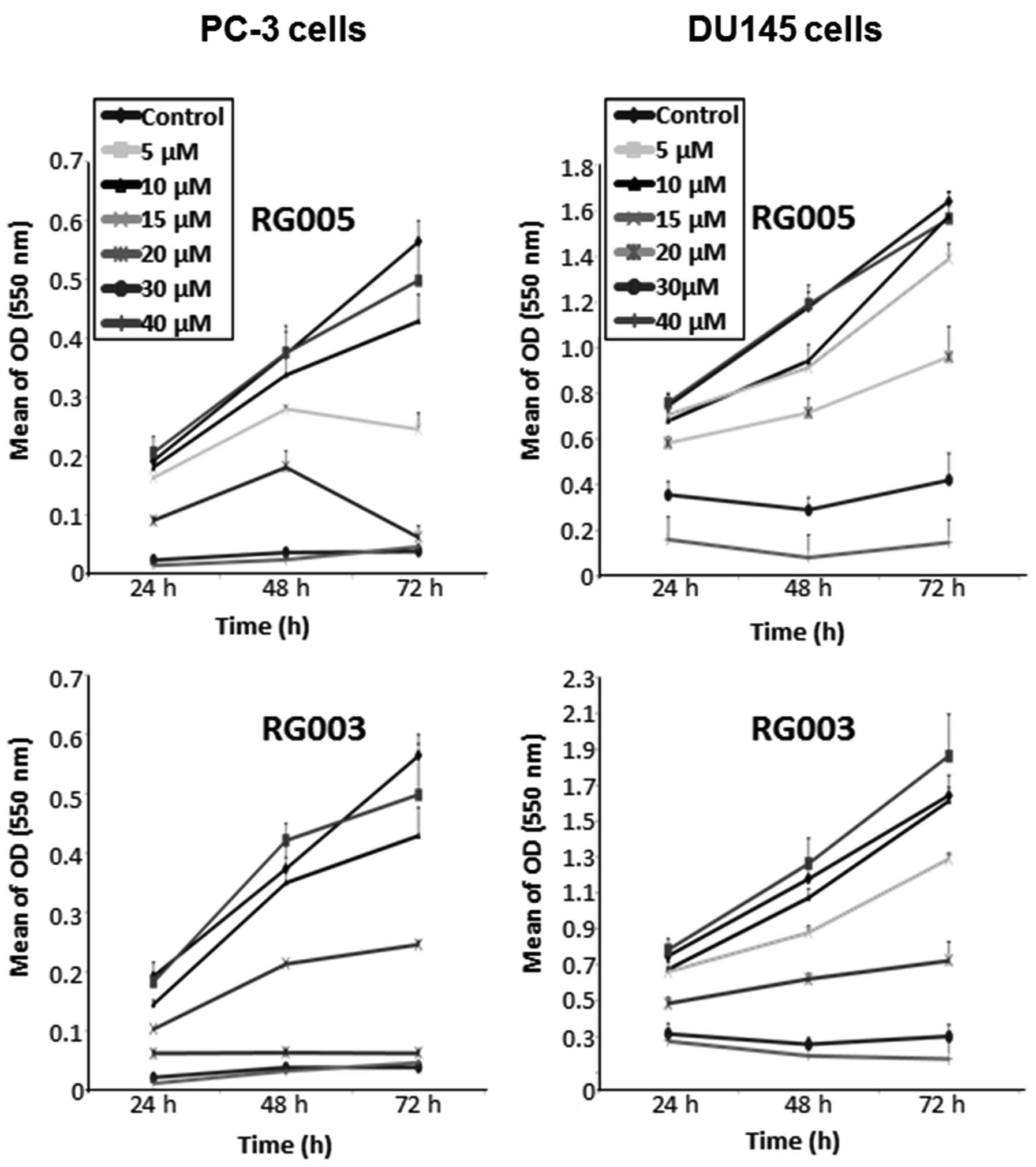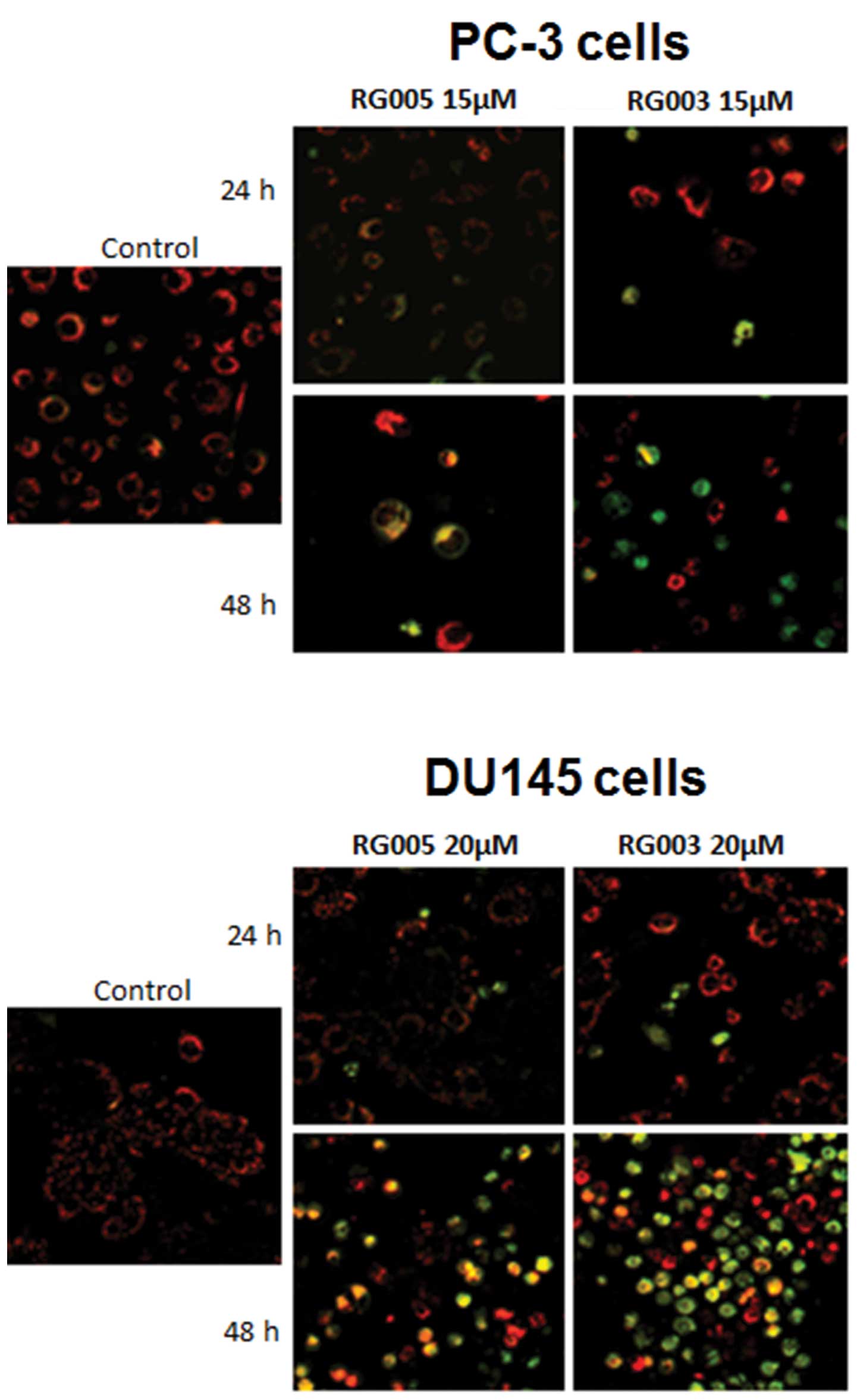|
1.
|
Jemal A, Siegel R, Ward E, Hao Y, Xu J and
Thun MJ: Cancer statistics, 2009. CA Cancer J Clin. 59:225–249.
2009. View Article : Google Scholar
|
|
2.
|
Dreicer R: Current status of cytotoxic
chemotherapy in patients with metastatic prostate cancer. Urol
Oncol. 26:426–429. 2008. View Article : Google Scholar : PubMed/NCBI
|
|
3.
|
Alcaraz MJ, Vicente AM, Araico A,
Dominguez JN, Terencio MC and Ferrándiz ML: Role of nuclear
factor-kappaB and heme oxygenase-1 in the mechanism of action of an
anti-inflammatory chalcone derivative in RAW 264.7 cells. Br J
Pharmacol. 142:1191–1199. 2004. View Article : Google Scholar : PubMed/NCBI
|
|
4.
|
Domínguez JN, León C, Rodrigues J, Gamboa
de Domínguez N, Gut J and Rosenthal PJ: Synthesis and evaluation of
new anti-malarial phenylurenyl chalcone derivatives. J Med Chem.
48:3654–3658. 2005.PubMed/NCBI
|
|
5.
|
Liu X and Go ML: Antiproliferative
activity of chalcones with basic functionalities. Bioorg Med Chem.
15:7021–7034. 2007. View Article : Google Scholar : PubMed/NCBI
|
|
6.
|
Aggarwal BB and Shishodia S: Molecular
targets of dietary agents for prevention and therapy of cancer.
Biochem Pharmacol. 71:1397–1421. 2006. View Article : Google Scholar : PubMed/NCBI
|
|
7.
|
Hu W and Kavanagh JJ: Anticancer therapy
targeting the apoptotic pathway. Lancet Oncol. 4:721–729. 2003.
View Article : Google Scholar : PubMed/NCBI
|
|
8.
|
Shen KH, Chang JK, Hsu YL and Kuo PL:
Chalcone arrests cell cycle progression and induces apoptosis
through induction of mitochondrial pathway and inhibition of
nuclear factor kappa B signalling in human bladder cancer cells.
Basic Clin Pharmacol Toxicol. 101:254–261. 2007. View Article : Google Scholar
|
|
9.
|
Smith WL, DeWitt DL and Garavito RM:
Cyclooxygenases: structural, cellular, and molecular biology. Annu
Rev Biochem. 69:145–182. 2000. View Article : Google Scholar : PubMed/NCBI
|
|
10.
|
Xie WL, Chipman JG, Robertson DL, Erikson
RL and Simmons DL: Expression of a mitogen-responsive gene encoding
prostaglandin synthase is regulated by mRNA splicing. Proc Natl
Acad Sci USA. 88:2692–2696. 1991. View Article : Google Scholar : PubMed/NCBI
|
|
11.
|
Gupta S, Srivastava M, Ahmad N, Bostwick
DG and Mukhtar H: Over-expression of cyclooxygenase-2 in human
prostate adenocarcinoma. Prostate. 42:73–78. 2000. View Article : Google Scholar : PubMed/NCBI
|
|
12.
|
Wenzel U, Kuntz S, Brendel MD and Daniel
H: Dietary flavone is a potent apoptosis inducer in human colon
carcinoma cells. Cancer Res. 60:3823–3831. 2000.PubMed/NCBI
|
|
13.
|
Corbiere C, Liagre B, Terro F and
Beneytout JL: Induction of antiproliferative effect by diosgenin
through activation of p53, release of apoptosis-inducing factor
(AIF) and modulation of caspase-3 activity in different human
cancer cells. Cell Res. 14:188–196. 2004. View Article : Google Scholar
|
|
14.
|
Smiley ST, Reers M, Mottola-Hartshorn C,
et al: Intracellular heterogeneity in mitochondrial membrane
potentials revealed by a J-aggregate-forming lipophilic cation
JC-1. Proc Natl Acad Sci USA. 88:3671–3675. 1991. View Article : Google Scholar
|
|
15.
|
Lepage C, Liagre B, Cook-Moreau J, Pinon A
and Beneytout JL: Cyclooxygenase-2 and 5-lipoxygenase pathways in
diosgenin-induced apoptosis in HT-29 and HCT-116 colon cancer
cells. Int J Oncol. 36:1183–1191. 2010.PubMed/NCBI
|
|
16.
|
Leger DY, Liagre B and Beneytout JL: Role
of MAPKs and NF-κB in diosgenin-induced megakaryocytic
differentiation and subsequent apoptosis in HEL cells. Int J Oncol.
28:201–207. 2006.
|
|
17.
|
Bertrand J, Liagre B, Ghezali L, Beneytout
JL and Leger DY: Cyclooxygenase-2 positively regulates Akt
signalling and enhances survival of erythroleukemia cells exposed
to anti-cancer agents. Apoptosis. 18:836–850. 2013. View Article : Google Scholar : PubMed/NCBI
|
|
18.
|
Ghezali L, Leger DY, Limami Y, Cook-Moreau
J, Beneytout JL and Liagre B: Cyclopamine and jervine induce COX-2
overexpression in human erythroleukemia cells but only cyclopamine
has a pro-apoptotic effect. Exp Cell Res. 319:1043–1053. 2013.
View Article : Google Scholar : PubMed/NCBI
|
|
19.
|
Green DR and Reed JC: Mitochondria and
apoptosis. Science. 281:1309–1312. 1998. View Article : Google Scholar : PubMed/NCBI
|
|
20.
|
Oltvai ZN, Milliman CL and Korsmeyer SJ:
Bcl-2 heterodimerizes in vivo with a conserved homolog, Bax, that
accelerates programmed cell death. Cell. 74:609–619. 1993.
View Article : Google Scholar : PubMed/NCBI
|
|
21.
|
MacKenzie SH, Schipper JL and Clark AC:
The potential for caspases in drug discovery. Curr Opin Drug Discov
Dev. 13:568–576. 2010.PubMed/NCBI
|
|
22.
|
Liu YQ, Hu XY, Lu T, Cheng YN, Young CY,
Yuan HQ and Lou HX: Retigeric acid B exhibits antitumor activity
through suppression of nuclear factor-κB signalling in prostate
cancer cells in vitro and in vivo. PLoS One.
7:e380002012.PubMed/NCBI
|
|
23.
|
Datta SR, Dudek H, Tao X, Masters S, Fu H,
Gotoh Y and Greenberg ME: Akt phosphorylation of BAD couples
survival signals to the cell-intrinsic death machinery. Cell.
91:231–241. 1997. View Article : Google Scholar : PubMed/NCBI
|
|
24.
|
Giri K and Aggarwal BB: Constitutive
activation of NF-kappaB causes resistance to apoptosis in human
cutaneous T cell lymphoma HuT-78 cells. Autocrine role of tumor
necrosis factor and reactive oxygen intermediates. J Biol Chem.
273:14008–14014. 1998. View Article : Google Scholar : PubMed/NCBI
|
|
25.
|
Wang D and Dubois RN: The role of COX-2 in
intestinal inflammation and colorectal cancer. Oncogene.
29:781–788. 2010. View Article : Google Scholar : PubMed/NCBI
|
|
26.
|
Kirschenbaum A, Liu X, Yao S and Levine
AC: The role of cyclooxygenase-2 in prostate cancer. Urology.
58:127–131. 2001. View Article : Google Scholar : PubMed/NCBI
|
|
27.
|
Lee KS, Lee HJ, Ahn KS, et al:
Cyclooxygenase-2/prostaglandin E2 pathway mediates icariside II
induced apoptosis in human PC-3 prostate cancer cells. Cancer Lett.
280:93–100. 2009. View Article : Google Scholar : PubMed/NCBI
|
|
28.
|
Hankey BF, Feuer EJ, Clegg LX, et al:
Cancer surveillance series: Interpreting trends in prostate
cancer-part I: evidence of the effects of screening in recent
prostate cancer incidence, mortality, and survival rates. J Natl
Cancer Inst. 91:1017–1024. 1999. View Article : Google Scholar
|
|
29.
|
Ganesh B, Saoba SL, Sarade MN and Pinjari
SV: Risk factors for prostate cancer: an hospital-based
case-control study from Mumbai, India. Indian J Urol. 27:345–350.
2011. View Article : Google Scholar : PubMed/NCBI
|
|
30.
|
American Dietetic Association; Dietitians
of Canada: Position of the American Dietetic Association and
Dietitians of Canada: Vegetarian diets. J Am Diet Assoc.
103:748–765. 2003. View Article : Google Scholar
|
|
31.
|
Hsing AW and Chokkalingam AP: Prostate
cancer epidemiology. Front Biosci. 11:1388–1413. 2006. View Article : Google Scholar
|
|
32.
|
Rodrigues J, Abramjuk C, Vásquez L, et al:
New 4-maleamic acid and 4-maleamide peptidyl chalcones as potential
multi-target drugs for human prostate cancer. Pharm Res.
28:907–919. 2011. View Article : Google Scholar : PubMed/NCBI
|
|
33.
|
Deb Majumdar I, Devanabanda A, Fox B,
Schwartzman J, Cong H, Porco JA Jr and Weber HC: Synthetic
cyclohexenyl chalcone natural products possess cytotoxic activities
against prostate cancer cells and inhibit cysteine cathepsins in
vitro. Biochem Biophys Res Commun. 416:397–402. 2011.
|
|
34.
|
Nagaraju M, Gnana Deepthi E, Ashwini C, et
al: Synthesis and selective cytotoxic activity of novel hybrid
chalcones against prostate cancer cells. Bioorg Med Chem Lett.
22:4314–4317. 2012. View Article : Google Scholar : PubMed/NCBI
|
|
35.
|
Jung JI, Lim SS, Choi HJ, et al:
Isoliquiritigenin induces apoptosis by depolarizing mitochondrial
membranes in prostate cancer cells. J Nutr Biochem. 17:689–696.
2006. View Article : Google Scholar : PubMed/NCBI
|
|
36.
|
Hengartner MO: The biochemistry of
apoptosis. Nature. 407:770–776. 2000. View Article : Google Scholar : PubMed/NCBI
|
|
37.
|
Zamzami N, Susin SA, Marchetti P, et al:
Mitochondrial control of nuclear apoptosis. J Exp Med.
183:1533–1544. 1996. View Article : Google Scholar : PubMed/NCBI
|
|
38.
|
Green D and Kroemer G: The central
executioners of apoptosis: caspases or mitochondria? Trends Cell
Biol. 8:267–271. 1998. View Article : Google Scholar : PubMed/NCBI
|
|
39.
|
Liu X, Kim CN, Yang J, Jemmerson R and
Wang X: Induction of apoptotic program in cell-free extracts:
requirement for dATP and cytochrome c. Cell. 86:147–157. 1996.
View Article : Google Scholar : PubMed/NCBI
|
|
40.
|
Lebedeva IV, Sarkar D, Su ZZ, et al: Bcl-2
and Bcl-x(L) differentially protect human prostate cancer cells
from induction of apoptosis by melanoma differentiation associated
gene-7, mda-7/IL-24. Oncogene. 22:8758–8773. 2003. View Article : Google Scholar
|
|
41.
|
Salvesen GS and Dixit VM: Caspases:
intracellular signalling by proteolysis. Cell. 91:443–446. 1997.
View Article : Google Scholar : PubMed/NCBI
|
|
42.
|
D’Amours D, Desnoyers S, D’Silva I and
Poirier GG: Poly(ADP-ribosyl)ation reactions in the regulation of
nuclear functions. Biochem J. 342:249–268. 1999.
|
|
43.
|
Nicholson DW: Caspase structure,
proteolytic substrates, and function during apoptotic cell death.
Cell Death Differ. 6:1028–1042. 1999. View Article : Google Scholar : PubMed/NCBI
|
|
44.
|
Chen X, Thakkar H, Tyan F, et al:
Constitutively active Akt is an important regulator of TRAIL
sensitivity in prostate cancer. Oncogene. 20:6073–6083. 2001.
View Article : Google Scholar : PubMed/NCBI
|
|
45.
|
Murillo H, Huang H, Schmidt LJ, Smith DI
and Tindall DJ: Role of PI3K signalling in survival and progression
of LNCaP prostate cancer cells to the androgen refractory state.
Endocrinology. 142:4795–4805. 2001. View Article : Google Scholar : PubMed/NCBI
|
|
46.
|
Testa JR and Bellacosa A: AKT plays a
central role in tumorigenesis. Proc Natl Acad Sci USA.
98:10983–10985. 2001. View Article : Google Scholar : PubMed/NCBI
|
|
47.
|
Madrid LV, Mayo MW, Reuther JY and Baldwin
AS Jr: Akt stimulates the transactivation potential of the RelA/p65
Subunit of NF-kappa B through utilization of the Ikappa B kinase
and activation of the mitogen-activated protein kinase p38. J Biol
Chem. 276:18934–18940. 2001. View Article : Google Scholar : PubMed/NCBI
|
|
48.
|
Ahn KS, Sethi G and Aggarwal BB: Nuclear
factor-kappa B: from clone to clinic. Curr Mol Med. 7:619–637.
2007. View Article : Google Scholar : PubMed/NCBI
|
|
49.
|
Yang P, Cartwright CA, Li J, et al:
Arachidonic acid metabolism in human prostate cancer. Int J Oncol.
41:1495–1503. 2012.PubMed/NCBI
|
|
50.
|
Narayanan NK, Narayanan BA and Reddy BS: A
combination of docosahexaenoic acid and celecoxib prevents prostate
cancer cell growth in vitro and is associated with
modulation of nuclear factor-κB, and steroid hormone receptors. Int
J Oncol. 26:785–792. 2005.PubMed/NCBI
|
|
51.
|
Sarveswaran S, Gautam SC and Ghosh J:
Wedelolactone, a medicinal plant-derived coumestan, induces
caspase-dependent apoptosis in prostate cancer cells via
downregulation of PKCε without inhibiting Akt. Int J Oncol.
41:2191–2199. 2012.PubMed/NCBI
|
|
52.
|
Patsos HA, Greenhough A, Hicks DJ, et al:
The endogenous cannabinoid, anandamide, induces COX-2-dependent
cell death in apoptosis-resistant colon cancer cells. Int J Oncol.
37:187–193. 2010.PubMed/NCBI
|
|
53.
|
Limami Y, Pinon A, Leger DY, et al: HT-29
colorectal cancer cells undergoing apoptosis overexpress COX-2 to
delay ursolic acid-induced cell death. Biochimie. 93:749–757. 2011.
View Article : Google Scholar : PubMed/NCBI
|
|
54.
|
Limami Y, Pinon A, Leger DY, et al: The
P2Y2/Src/p38/COX-2 pathway is involved in the resistance to ursolic
acid-induced apoptosis in colorectal and prostate cancer cells.
Biochimie. 94:1754–1763. 2012. View Article : Google Scholar : PubMed/NCBI
|
|
55.
|
Mencher SK and Wang LG: Promiscuous drugs
compared to selective drugs (promiscuity can be a virtue). BMC Clin
Pharmacol. 5:32005. View Article : Google Scholar : PubMed/NCBI
|
|
56.
|
Trouillas P, Corbière C, Liagre B, Duroux
JL and Beneytout JL: Structure-function relationship for saponin
effects on cell cycle arrest and apoptosis in the human 1547
osteosarcoma cells: a molecular modelling approach of natural
molecules structurally close to diosgenin. Bioorg Med Chem.
13:1141–1149. 2005. View Article : Google Scholar
|

















